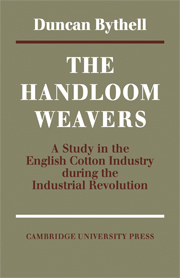Book contents
- Frontmatter
- Contents
- Preface
- Introduction
- Map of the weaving towns and villages of north-east Lancashire in 1821
- 1 Problems and sources
- 2 The organization of the industry
- 3 The labour force
- 4 The coming of the powerloom
- 5 Wages: (I) The piece-rate
- 6 Wages: (II) Earnings and the standard of living
- 7 Public opinion and the handloom weavers
- 8 Organized industrial action among the cotton handloom weavers
- 9 The weavers and radical politics
- 10 The problem of poverty
- 11 Displacement and disappearance
- Appendix 1 Some piece-rate series
- Appendix 2 The piece-rate and the price of food
- Appendix 3 G. H. Wood's estimates of average weekly earnings
- Bibliography
- Index
2 - The organization of the industry
Published online by Cambridge University Press: 07 October 2011
- Frontmatter
- Contents
- Preface
- Introduction
- Map of the weaving towns and villages of north-east Lancashire in 1821
- 1 Problems and sources
- 2 The organization of the industry
- 3 The labour force
- 4 The coming of the powerloom
- 5 Wages: (I) The piece-rate
- 6 Wages: (II) Earnings and the standard of living
- 7 Public opinion and the handloom weavers
- 8 Organized industrial action among the cotton handloom weavers
- 9 The weavers and radical politics
- 10 The problem of poverty
- 11 Displacement and disappearance
- Appendix 1 Some piece-rate series
- Appendix 2 The piece-rate and the price of food
- Appendix 3 G. H. Wood's estimates of average weekly earnings
- Bibliography
- Index
Summary
The complete history of the cotton industry during the industrial revolution, like that of many other industries, has never been written. To study its many ramifications during the crucial period of change from the last decades of the eighteenth century to the middle of the nineteenth—the development of sources of raw materials and of markets, the expansion of output, the social consequences of technical change in the various branches, the internal organization of the industry, and the place of cotton within the whole economy–would be a vast undertaking. In a study of only the weaving section of the industry during this period, many of these aspects must be ignored completely. Yet weaving must be seen within its proper context of the industry as a whole, and before the particular problems which came to face the hand workers in this one section of the industry can be examined, a few general points about the structure of the English cotton trade during the industrial revolution need to be established.
The size of cotton as compared with other contemporary industries during the first half of the nineteenth century must never be forgotten. Measured by the imports of cotton wool, the industry's raw material, which came entirely from abroad, the cotton industry grew in the last three decades of the eighteenth century from almost nothing to a position where it provided more employment and more exports than any other in the kingdom.
- Type
- Chapter
- Information
- The Handloom Weavers , pp. 25 - 39Publisher: Cambridge University PressPrint publication year: 1969



